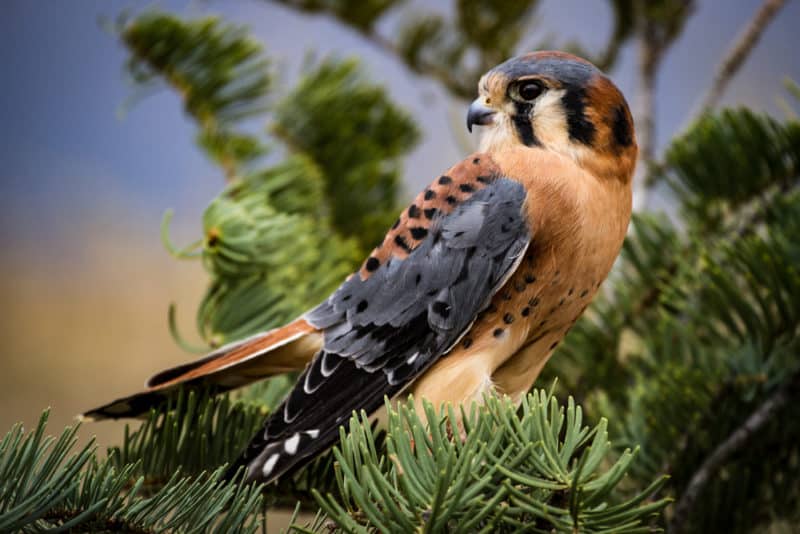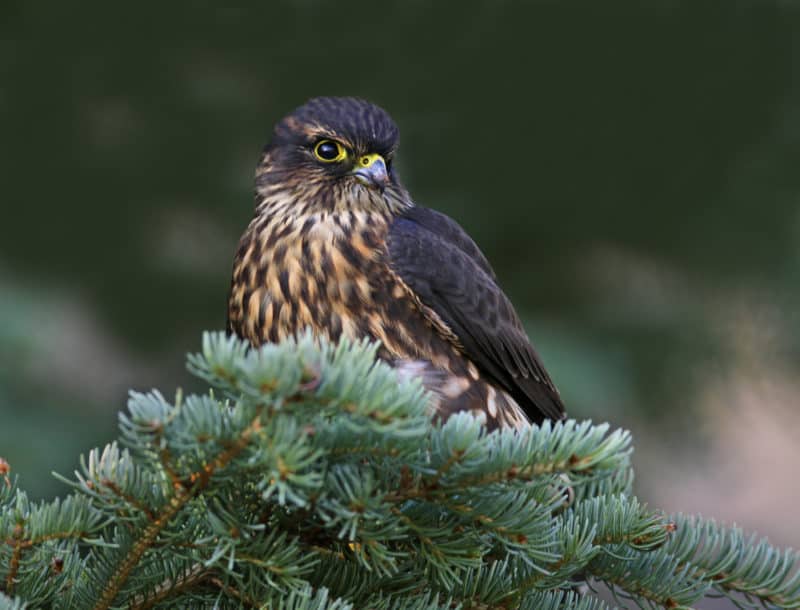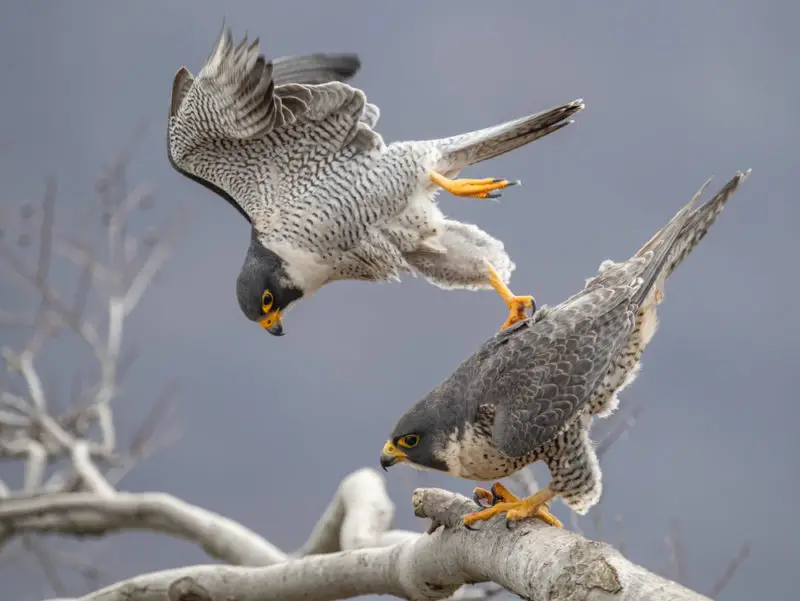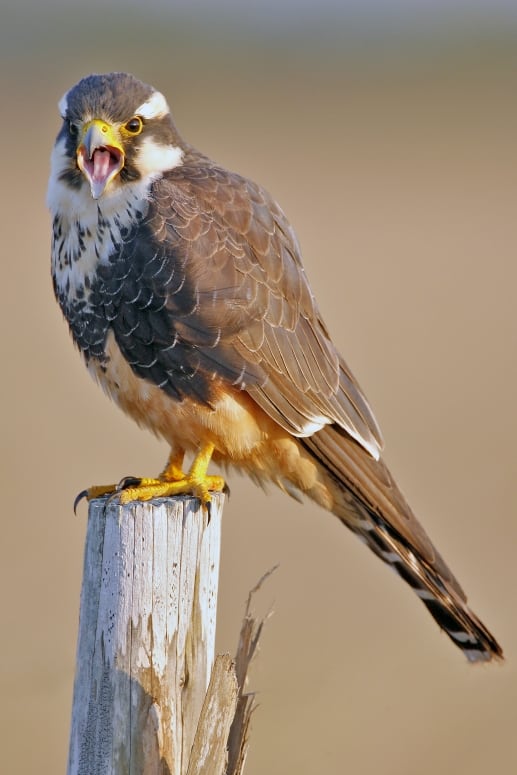Falcons are small to medium-sized daytime or diurnal hunting birds of prey in the genus Falco. They come in many different colors, shapes, and sizes. North American falcons can weigh 2.8 ounces to 4.5 pounds. Six species of falcon are found in North America. There are around 40 falcon species worldwide.
These birds are particularly skilled hunters with hooked beaks and sharp claws to catch and eat their prey. They prey on mammals, amphibians, insects, birds, and reptiles. The species of North American falcon include:
- American Kestrel
- Merlin Falcon
- Gyrfalcon
- Peregrine Falcon
- Prairie Falcon
- Aplomado Falcon

American Kestrel
The American kestrel is a falcon found throughout North America, including Canada and Alaska, also called the sparrow hawk. The bird usually lives close to open fields. It hovers or perches on a high vantage point as it searches for prey. Its size is roughly that of a Mourning Dove, but with a wider tail and larger head. It has slim and pointed falcon-shaped wings, as well as a tail with a square-like tip. The bird’s flying style is quick and buoyant with swept-back wings. Both males and females have dark eyes typical of falcons, and on the face, it has 2 bold, dark mustache marks framing white cheeks.
Mating Behavior
During the breeding season, the bird uses cavity nests, dead trees, a hollow giant cactus in the Southwest, or a dirt bank. It can also use nest boxes placed on high telephone poles and trees. Depending on the availability of food, the sparrow hawk can brood up to 5 or 6 young.
Hunting Technique
The sparrow hawk hunts using energy-conserving techniques by perching and scanning the ground for prey. However, it also hunts from the air. The bird’s diet consists of insects such as grasshoppers, small birds, lizards, and mice. Its diverse diet has contributed significantly to the species’ success.
When migrating, breeders from the north follow the traditional fall migration routes to wintering ranges in Southern America and Northern Mexico. The Eastern populations migrate using the coastlines more compared to the inland corridors.
During winter, a majority of these birds spend time in the Southern United States. You’ll find them spaced out on telephone poles scanning the area for prey, especially in agricultural areas. Food sources in snow-covered states determine the number of birds wintering in the region.

Merlin Falcon
Also known as the Pigeon Hawk, the merlin falcon is small and dark. This uncommon bird breeds in various parts of North America, including the open lands of Canada and Alaska and the northern and western parts of the continental United States. The Merlin also breeds in some parts of Europe and Asia. This species has recently taken up residence in urban and suburban areas with increased incidence.
Merlins are slightly larger than American Kestrels. Like other falcons, a merlin has long, thin wings and a long tail. This helps the bird to engage in active flight. Merlins are direct flyers that flap their wings with short, powerful, piston-like wingbeats.
Mating Behavior
The Merlin Falcon is monogamous. Breeding pairs winter separately, and during spring, the birds form a new bond or re-establish an old bond. The birds often return to the same breeding area and reoccupy the same nesting territory. Individual nest-site reuse is not common for them. Male Merlins get back to the breeding grounds one month before the females. Females may remain in the nesting area all year long. The bird does not build its nest but uses the abandoned nests of other birds, especially magpies and raptors. They also nest on cliff ledges, cavities in trees or buildings, or create depressions on the ground.
Hunting Technique
Merlins hunt on the wing and from perches. When hunting, Merlins employ surprise. Mostly, they use this technique when flying below the canopy to flush prey and when hunting from concealed perches. Sometimes, the bird will use landscapes such as hills to hide their approach. Early morning and late afternoon is when the bird’s hunting activity peaks. These falcons often prey on small shorebirds, especially during winter, and have the ability to take down birds as large as pigeons or small ducks.

Gyrfalcon
Gyrfalcons are the largest of the falcon species. Males are a bit larger than a Peregrine Falcon, while females are close to a Red-tailed Hawk size. Most Gyrfalcons are white with black spotting. They can also occur in grey and even brownish color variations. Source
These birds are fierce predators that reign over the desolate coasts of the high Arctic. In this region, the Gyrfalcon preys on large birds like waterfowl and ptarmigan. They are extremely powerful and fly faster than their prey.
Many of these birds remain in the north year-round, while a few migrate south to around the Canadian border during winter.
Hunting Technique
The Gyrfalcon hunts by scanning its environs while flying or high on a rock. The bird hunts using the surprise technique. It hunts medium-sized and large birds such as geese, gulls, and ducks. The Gyrfalcon also hunts small mammals such as hares, lemmings, and ground squirrels. On several occasions, researchers have spotted wintering Gyrfalcon taking large birds like the Sage Grouse. It feeds on other species occasionally.
Mating Behavior
Male gyrfalcons begin defending nesting territory in late January. Females begin to arrive at nesting areas in March. Pairs start nesting in April. Most bird’s nest sites are high on cliffs and abandoned nests built by other birds like Golden Eagles and ravens. The Gyrfalcon does not add any materials to its existing nest.
Female Gyrfalcons lay three to five eggs, which are incubated for about five weeks. Both parents perform incubation duties, with the female doing the majority of it.
The young are brooded most of the time for the first one to three weeks by the female while the male does most of the hunting. After two or three weeks, both parents hunt.
After 45 to 50 days, the chicks will take their first flight. Source
Male Gyrfalcons perform aerial displays with dives and rolls around their nest. The pair will defend a nearly a mile-wide territory. Nesting territories are spaced between 3 and 60 miles from the nearest pair. Source

Peregrine Falcon
Peregrine Falcons are the largest Falcon species over most of North America. Only the Gyrfalcon is larger. Peregrines are roughly the size of a crow. Adult Peregrines are grey on the back with a dark grey head. They are white underneath with grey bars. Source
Hunting Technique
Historically known as the duck hawk, Peregrine falcons prey upon other birds in mid-flight. These birds hunt from above. When they sight their prey, they drop in a sweep and swift drive over 200 miles an hour. They close their feet and use them to knock their prey out of the sky.
Researchers estimate that peregrine falcon prey on between 1,500 and 2000 bird species. However, they commonly prey on medium-sized birds like waterfowl, waders, pigeons, and doves, as well as songbirds.
Peregrine falcons are common birds of prey available on all continents apart from Antarctica. The bird prefers wide-open spaces and does well in coastal regions where shorebirds are common. However, they are present everywhere, including in deserts and tundra. In major cities, you can find the Peregrines living on skyscrapers and bridges.
These birds are known to travel outside the nesting season. However, some are permanent residents. The ones that winter in South America and nest in the Arctic cover up to 15,500 miles annually. The birds have a homing instinct that guides them back to their favored areas.
Mating Behavior
Males put on an aerial courtship display to attract a mate. The female gets to choose. Peregrines mate for life. They generally return each year to the same area and even the same nest. The female will potentially accept a new mate if the first is killed. Some of these bird’s nesting sites have been active for centuries and occupied by multiple successive generations.
To the Brink Of Extinction
During the mid-20th century, Peregrine’s population was going down at an alarming rate. In the U.S, the birds even joined the endangered species list.
The pesticide, Dichlorodiphenyltrichloroethane or DDT, came into wide use from the mid-1940s through 1972. DDT was very effective in controlling agricultural pests and disease-carrying mosquitos.
Unfortunately, it was discovered that DDT was also very harmful to raptor birds that sit at the top of the food chain, like the Peregrine Falcon. The poison accumulated in the raptor’s system after consuming other birds that fed on seeds, insects, and fish that were contaminated with DDT.
High concentrations of DDT prevented these birds from utilizing calcium normally. This translated into females laying eggs with thin, frail shells that would break under the parent’s weight during incubation.
Many eggs did not hatch, and populations precipitously dropped until, in the Peregrine case, a mere 12 percent of the previous population remained in the United States.
The use of DDT was banned in 1972.
Back From The Brink
The Peregrine Fund was established in 1974. It, along with various agencies in both the United States and Canada, embarked on a quest to save and re-establish the peregrine Falcon
Researchers at Cornell University successfully bred Peregrines in captivity. They hatched Peregrine eggs in a lab. The chicks were raised in the lab until they were three weeks old. At that point, they were placed in artificial nesting sites where they were fed and cared for by unseen humans until their survival skills were developed enough for them to become independent. In this way, more than 6,000 American Peregrine falcons have been released in North America since 1974. Source
In the United States and Canada, populations are now strong, and in some areas of the planet, there actually may be more Peregrines than existed before their 20th-century decline. Source

Prairie Falcon
The Prairie Falcon is basically the size of a peregrine falcon. They are marked a bit differently, though. Prairie Falcons are brown on their topsides and pale with brown markings on the breast and belly. From below, they show dark under the wing. From a top view, their tail is pale in contrast to their back and wings. They have a pale stripe above the eye and a brown mustache stripe.
Hunting Technique
Prairie falcons also differ from peregrines in their hunting technique. They prefer to fly low and fast over the landscape to take their prey by surprise. They can also pursue birds in flight or dive steeply and swiftly from the air. Prairie falcons feed on small mammals and birds. Ground squirrels are their common prey during early summer. They focus on songbirds as well as flocking birds such as Horned Larks during winter.
The Prairie Falcon is common in desert wilderness and desolate plains but can also adapt altered landscapes. The bird species flies over southwestern cities during winter.
Mating Behavior
During the breeding season, the male performs aerial acrobatics at the nesting site. Nesting is mostly in a recessed site, on a cliff ledge, or rocks. Sometimes, the bird can nest on a dirt bank or use an abandoned nest made by other birds, especially a raven.
The female Prairie Falcon lays between 3 and 6 eggs that are whitish with brown spots. The incubation period is around 31 days. The male hunts and brings food to the incubating female and may sit on the eggs when the female is eating. For the first 4 weeks, the female remains with the young as the male brings food. The young may leave the nest between 5 and 6 weeks after hatching.

Aplomado Falcon
The Aplomado is a medium-sized falcon. The species is colorful like the American Kestrel but bigger and bolder in size. It has tricolored underparts and black-and-white facial stripes. The long-tailed and long-winged bird has black patches on the lower breast, which meet in the middle. The species has a black tail with narrow grey and white bars as well as a white tip.
The Aplomado Falcon lives in coastal grasslands and deserts with scattered mesquites and yuccas in the U.S. The bird uses woodland edges close to grasslands, coastal savannas, and marshes in Mexico.
The biggest share of this bird’s territory is in South America. In the grasslands of Ecuador, Chile, and Peru, they range from sea level to over 13,000 feet.
Mating Behavior
The species nests in trees, wooded areas near marshes, oak woodlands, and yuccas in open grasslands. Some of these birds also nest directly on the ground or the crossbeams of power poles. They do not build nets but use stick nests that crows, magpies, raptors, and jays have abandoned.
At the beginning of the mating season, the male and female begin to display to each other. Their courtship behavior may include aerial displays, loud calls, and quiet “e-chups” made to each other. They also mite exchange items of food.
Hunting Technique
Aplomados feed on insects, small birds, and mammals, as well as lizards. The bird takes down small birds and insects on the wing or chases prey on foot. If in pairs, the birds hunt cooperatively. One bird scares the prey while the other one intercepts it.
The Aplomado Falcon is very powerful and fast in-flight, easily outpacing White-winged Doves. It can also run fast on the ground to chase prey. Most of these falcons perch on inner tree branches when roosting. During the mating season, both females and males move from one perch to the other and chase each other at full speed.
When Your Outdoors Look Up from Time To Time
You might be lucky enough to spy on one of these awesome birds of prey. From the tiny yet gritty American Kestrel to regal and fierce Gyrfalcon, we are richer to have these birds to enjoy than we would be without them.
Recent Posts
The only venomous snakes in Washington State are Northern Pacific Rattlesnakes. The Northern Pacific Rattlesnake (Crotalus oreganus oreganus) is a sub-species of the Western Rattlesnake. Anyone...
Skunks are not classified as true hibernators. But they go into a state of torpor when the weather gets cold. Skunks are light sleep hibernators, along with opossums, bears, and raccoons. ...
